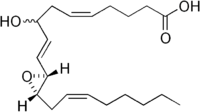Hepoxilin
| Hepoxilin A3 | ||
|---|---|---|
 | ||
| IUPAC name (5E,9E)-8-hydroxy-10-[3-[(E)-oct-2-enyl] -2-oxiranyl]deca-5,9-dienoic acid | ||
| Other names HXA3 | ||
| Identifiers | ||
| CAS number | 94161-11-2 | |
| PubChem | 5353666 | |
| Jmol-3D images | Image 1 | |
| ||
| Properties | ||
| Molecular formula | C20H32O4 | |
| Molar mass | 336.47 g/mol | |
| Except where noted otherwise, data are given for materials in their standard state (at 25 °C (77 °F), 100 kPa) | ||
| Infobox references | ||
Hepoxilins (HxA3 and HxB3) are nonclassic eicosanoid hormones involved in inflammation.
History
Hepoxilins were identified and named in Canada in 1984 by CR Pace-Asciak and JM Martin.[1]
Biochemistry
They derive from arachidonic acid via oxidation by the enzyme 12-lipoxygenase. Hepoxilins are differentiated from closely related eicosanoids, the leukotrienes and the lipoxins, in that hepoxilins have no conjugated double bonds. Corresponding trioxlins A4 and B4 are formed by the same pathway from EPA [2]
Physiological effect
In the skin, Hx are pro-inflammatory, but in neutrophils they are anti-inflammatory.[3] Hx are potent insulin secretagogues.[2] One hepoxilin, HepA3, mediates neutrophil migration across the intestines.[4] Hepoxilins are also produced in the brain.[5] Cells under oxidative stress secrete HX3, which in turn upregulates peroxidase, decreasing oxidative stress. This is proposed to constitute a compensatory defense response to protect the vitality and functionality of the cell.[6]
References
- ↑ Pace-Asciak CR, Martin JM (1984). "Hepoxilin, a new family of insulin secretagogues formed by intact rat pancreatic islets". Prostaglandins, leukotrienes, and medicine 16 (2): 173–80. doi:10.1016/0262-1746(84)90069-6. PMID 6396652.
- ↑ 2.0 2.1 Pace-Asciak CR (1986). "Formation of hepoxilin A4, B4 and the corresponding trioxilins from 12(S)-hydroperoxy-5,8,10,14,17-icosapentaenoic acid". Prostaglandins, leukotrienes, and medicine 22 (1): 1–9. doi:10.1016/0262-1746(86)90017-X. PMID 3012585.
- ↑ Christie, William W. (2006). "LEUKOTRIENES AND LIPOXINS: Chemistry and Biology". Retrieved January 4, 2007.
- ↑ Randall J. Mrsny, Andrew T. Gewirtz, Dario Siccardi, Tor Savidge , Bryan P. Hurley , James L. Madara, and Beth A. McCormick (2004). "Identification of hepoxilin A3 in inflammatory events: A required role in neutrophil migration across intestinal epithelia". Proceedings of the National Academy of Sciences of the United States of America 101 (19): 7421–6. doi:10.1073/pnas.0400832101. PMC 409934. PMID 15123795. Retrieved January 4, 2007.
- ↑ Piomelli, Daniele (2000). "Arachidonic Acid". Neuropsychopharmacology: The Fifth Generation of Progress (New York: Chapman & Hall). ISBN 0-412-10951-4. Retrieved 2006-03-03.
- ↑ M.P. Zafiriou et al. (October-November 2007). "Prostaglandins, Leukotrienes and Essential Fatty Acids : Biological role of hepoxilins: Upregulation of phospholipid hydroperoxide glutathione peroxidase as a cellular response to oxidative stress?". Prostaglandins, Leukotrienes and Essential Fatty Acids 77 (3–4): 209–215. doi:10.1016/j.plefa.2007.08.007. PMID 17997296. Retrieved 2007-12-04.